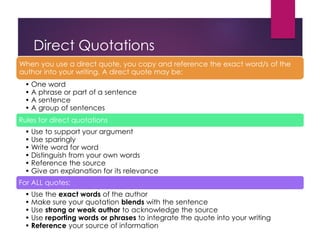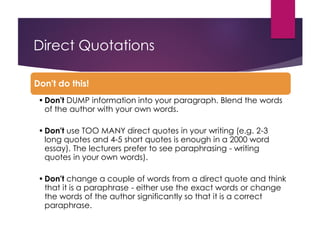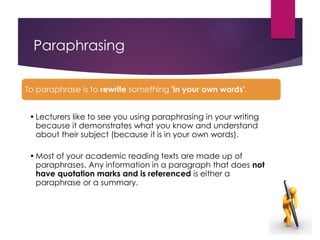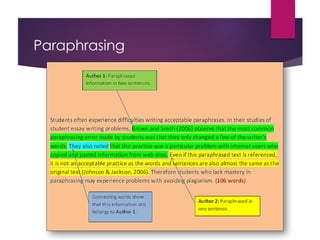The document describes different methods for incorporating outside information into writing, including quoting, paraphrasing, and summarizing. It defines quoting as using the exact words of the author, while paraphrasing is rewriting the information in one's own words. Summarizing involves condensing longer passages into a shorter overview while maintaining the key points. The document provides guidance on formatting, citing sources, and avoiding plagiarism for each method.



![Direct Quotations
It takes practice and experience for students to learn how to use direct quotes effectively in
their writing. According to Princeton Writing Centre (2009), direct quotes should only be used
to provide support for academic argument for a “compelling” reason and that the choice to
quote may be because “you want your readers to be able to see, in full, what someone else
has said” (PWC, 2009, p.7). Students often misunderstand the role of quotes in writing and
overdo the strategy.
Students include four quotations where one would do. This can give the impression that
you don't have enough to say and are using quotations to take up space [a common
strategy for some students]. Also, the excessive use of quotes ... may be taken to
indicate that you don't understand the position well enough to explain it in your own
words (Dartmouth, 2008, p.27).
Moreover, there are a number of technical rules that students need to learn to use quotations
correctly in their writing, such as formatting, punctuation, verb tense and adding emphasis.
Students, then, require information and training to assist them to use quotations
appropriately and correctly in the academic writing. (188 words)](https://image.slidesharecdn.com/week1summarizingparaphrasingrussellrodrigo-170524110228/85/Week-1-Quoting-Paraphrasing-Summarizing-4-320.jpg)

![Long Quotations
Long quotes are more than 40 words OR three typed lines.
• Follow these conventions:
• leave no space above and below the long quote
• make the text size the same as the essay text size
• indent approximately one centimetre to the right
• do NOT use quotation marks
Example
Students often misunderstand the role of quotations in writing and overdo the strategy:
Students include four quotations where one would do. This can give the impression
that you don't have enough to say and are using quotations to take up space [a
common strategy for some students]. Also, the excessive use of quotes ... may be
taken to indicate that you don't understand the position well enough to explain it in
your own words (Dartmouth, 2008, p.27). (61 words)
Moreover, there are a number of technical rules that students need to learn to use
quotations correctly in their writing.](https://image.slidesharecdn.com/week1summarizingparaphrasingrussellrodrigo-170524110228/85/Week-1-Quoting-Paraphrasing-Summarizing-6-320.jpg)
![Modifying Quotations
Making a change Correct convention
Leaving out some words (because
you may not need all of the words
in the middle of the quote)
Use an ellipsis signal (three dots ... ).
Leave a space either side of the 3
dots
Changing the capitalisation of a
letter
Use square brackets [ ] around the
letter
Adding words to the quote (without
changing the meaning)
Use square brackets [ ] around the
added words
The following table gives you a few of the most common rules for
modifying the words of authors in a direct quote:](https://image.slidesharecdn.com/week1summarizingparaphrasingrussellrodrigo-170524110228/85/Week-1-Quoting-Paraphrasing-Summarizing-7-320.jpg)
![Modifying Quotations
[S]tudents include four quotations where one would do. This
can give the impression that you don’t have enough to say
and are using quotations to take up space [a common
strategy for some students]. Also, the excessive use of
quotes... may be taken to indicate that you don’t
understand the position well enough to explain it in your own
words (Dartmouth, 2008, p.11).
[S]tudents include four quotations where one would do. This can give the impression
that you don’t have enough to say and are using quotations to take up space [a
common strategy for some students]. Also, the excessive use of quotes... may be
taken to indicate that you don’t understand the position well enough to explain it in
your own words (Dartmouth, 2008, p.11).
Shows a capital letter has been
added to the original text.
Shows a comment has been
added to the original text.
Shows some words have been
left out of the original text.](https://image.slidesharecdn.com/week1summarizingparaphrasingrussellrodrigo-170524110228/85/Week-1-Quoting-Paraphrasing-Summarizing-8-320.jpg)











